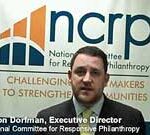Why Don’t Foundations Build Capacity in Fundraising?
Why do so few grantmakers invest in building the capacity for nonprofits to raise independent money?

Nonprofits with more independent funding sources can avoid backseat driving by foundations.
“The most significant regret I have in looking over my 15 years as a leader of two big philanthropies is that, while we thought a lot about sustainability at the Open Society Foundations and at the Atlantic Philanthropies, we rarely made grants to strengthen organizations’ fundraising.”
So said Gara La Marche in an op-ed in the Chronicle of Philanthropy. (Gara is president of the Democracy Alliance and vice chair of NCRP’s board.)
The problem with foundation money.
The problem, of course, with grassroots organizations relying too heavily on foundation funding is that sometimes foundations and their grantees have different ideas about goals and strategies. When grantees have little independent funding, their hands are tied. If they want the money, they need to work on the issues foundations are willing to fund and employ foundations’ preferred strategies.
Former executive director of the Neighborhood Funders Group Spence Limbocker put it this way: “As long as community groups are totally dependent on grants from foundations and other funders, they will be controlled by the whims of their major supporters and the ups and downs of the stock market. This is why it is important that community organizing groups develop a diversified funding base and that grantmakers support these efforts.” (emphasis added)
Earned income, corporate support, memberships in grassroots organizations.
Limbocker’s article details the work of the Washington Interfaith Network (WIN), an affiliate of the Industrial Areas Foundation, to build an earned-income strategy with a real-estate development company. This income stream has the added benefit of being mission-critical, helping to provide housing options for low-income families.
Other examples:
- National People’s Action (NPA), which recently released a report documenting their early experiments to build a street canvassing operation that will bring in new members and contributors, and they’re helping affiliates ask members and allies for support well beyond basic annual dues.
- The Center for Popular Democracy (CPD) has also been running fundraising experiments with its local partner organizations. Their forthcoming report — which they shared with me — shows both promising success stories and a few failures in memberhsip canvassing efforts. (Full disclosure: I serve as vice chair of CPD’s board.)
- Groups affiliated with the Direct Action and Research Training Center (DART) have been among the least dependent on foundation funding over the past two decades. Many DART affiliates raise the vast majority of their funding from membership dues, individuals, and local corporations. For the network as a whole, 58%of revenue came from non-foundation sources last year – a figure that is quite high for organizations of this kind.
- Organizing groups affiliated with the Gamaliel Foundation raise about 45% of their revenue from non-foundation sources, a combination of membership dues, fundraising events and individual donors.
Still rare.
My inquiries have uncovered only two foundations – the Ford Foundation and the Marguerite Casey Foundation (MCF) – that consistently and systematically invest in building the capacity of community organizing groups to raise money independently.
At Ford, program officer Jee Kim reports that he is investing about one quarter of his portfolio in these fundraising experiments, about 1.5 million per year. “I invest in this work because the future of our democracy and the health of communities depends on having strong, sustainable and independent grassroots power.”
MCF provides multi-year general-support grants to nonprofits to diversify their funding bases, and in a recent survey, almost three-quarters (74%) of grantees agreed that, as a result of MCF’s support, they have done so. In addition MCF funded 18 pilot projects for more than $2.6 million. Grantees tested initiatives including social media campaigns, apps, street canvassing programs and town halls to build membership. Almost across the board they found that low-income families were willing to pay at least a nominal amount to be members, and that an approach that incorporates both face-to-face and online contact is most effective.
So why don’t foundations fund fundraising capacity?
Why don’t more foundations invest in helping their organizing grantees develop independent funding streams? Here – as with many issues grantees face – even a little targeted capacity-building support would go a long way.
Several people I respect have suggested to me privately that foundations don’t actually want their grantees to develop independent funding because foundation staff would then lose some of their power to dictate goals and strategies. I don’t share this view — I think it’s more complicated than that, and that the barriers to investing in this work differ from one foundation to the next. However, funders need to recognize that their failure to help grantees develop financial independence looks to some like a power grab.
For funders who want to begin investing in this work, here is how to get started:
- First, have some conversations with your grantees. It’s important to understand what they are already doing to raise independent money and how it’s been going for them. You also need to know what they’ve been wanting to try but haven’t had the chance to yet.
- Second, make some grants as experiments. You’re trying to learn, and help your grantees learn, what works. Be very cautious of paying for consultants – most fundraising consultants don’t really understand grassroots organizing groups and you’ll just be wasting your money.
- Third, figure out how to help your grantees scale what’s working for them. If one approach is producing results, would investing more in that approach produce even better results? If so, make the investment. We don’t always need to go after something new.
Kudos to the few foundations mentioned above who have invested in this important work. Are there other examples I’ve missed? Please let me know in the comments or via email of foundations that are helping grantees develop independent funding. It’s urgent, important work.
Editor’s note: We learned that the Evelyn & Walter Haas, Jr. Fund in San Francisco is developing an initiative to support nonprofit fundraising based on what they’ve learned from UnderDeveloped: A National Study of Challenges Facing Nonprofit Fundraising by CompassPoint.
About the Author
Aaron Dorfman is executive director of the National Committee for Responsive Philanthropy (NCRP). Follow @NCRP on Twitter. Aaron is also investigating the lack of foundation support for developing a no-calorie ice cream.
Articles on Blue Avocado do not provide legal representation or legal advice and should not be used as a substitute for advice or legal counsel. Blue Avocado provides space for the nonprofit sector to express new ideas. Views represented in Blue Avocado do not necessarily express the opinion of the publication or its publisher.












As a nonprofit that helps other New York-area nonprofits build their fundraising and governance capacity (bingo!), we at Cause Effective (www.causeeffective.org) are well aware of the trends of which you speak.
But I have to give a shout-out to the steadfast commitment of The New York Community Trust, New York Women’s Foundation, Mertz Gilmore Foundation, and other local foundations to supporting fundraising capacity-building in New York (including the New York Technical Assistance Providers Network, composed of many local social change funders who pool their resources to have greater impact). In addition, last year and again this year, the New York City Council allocated $2.5 million for capacity-building to nonprofits located in and led by communities of color – a good percentage of which was spent on increasing fund development capacity.
In New York City, there’s long been a robust conversation among local funders and nonprofits on the true needs of nonprofits to develop sustainability. Not that the funder support I cited is enough – we’ve got 30,000 nonprofits in our town – but it’s very much here, and credit should be given.
(And in fact, Cause Effective had several years of Open Society Foundations support to work with over a dozen NYC social justice nonprofits build their fundraising capacity.)
I’m so glad to hear about the investments of those foundations in this important work. Thanks for the comment!
As a nonprofit that helps other New York-area nonprofits build their fundraising and governance capacity (bingo!), we at Cause Effective (www.causeeffective.org) are well aware of the trends of which you speak.
But I have to give a shout-out to the steadfast commitment of The New York Community Trust, New York Women’s Foundation, Mertz Gilmore Foundation, and other local foundations to supporting fundraising capacity-building in New York (including the New York Technical Assistance Providers Network, composed of many local social change funders who pool their resources to have greater impact). In addition, last year and again this year, the New York City Council allocated $2.5 million for capacity-building to nonprofits located in and led by communities of color – a good percentage of which was spent on increasing fund development capacity.
In New York City, there’s long been a robust conversation among local funders and nonprofits on the true needs of nonprofits to develop sustainability. Not that the funder support I cited is enough – we’ve got 30,000 nonprofits in our town – but it’s very much here, and credit should be given.
(And in fact, Cause Effective had several years of Open Society Foundations support to work with over a dozen NYC social justice nonprofits build their fundraising capacity.)
I’m so glad to hear about the investments of those foundations in this important work. Thanks for the comment!
As CEO of the Maine Women’s Fund, a statewide public foundation that supports programs addressing challenges to economic security for women and girls in Maine, I am proud that for the past two years we provided technical support in resource development for our grantees. Giving fish is not a long-term solution, but teaching to fish is.
Fantastic!
As CEO of the Maine Women’s Fund, a statewide public foundation that supports programs addressing challenges to economic security for women and girls in Maine, I am proud that for the past two years we provided technical support in resource development for our grantees. Giving fish is not a long-term solution, but teaching to fish is.
Fantastic!
Hear hear! I’m especially grateful for your caution about paying for consultants. Too often the capacity grants that foundations make for fundraising (or other projects, such as strategic planning) only pay for consultants and other direct expenses, when nonprofits most need help developing in-house expertise. Paying for a new staff position and/or staff training, along with other costs such as list rentals and possibly a modest consulting gig to get a group started, can be transformational for a nonprofit, particularly a grassroots organizing organization.
I read this articlewith great interest because it was a surprise to me. Our small Foundation has always invested in building the capacity of our grantees.
Springboard Foundation funds new, (under 3 years old) and small (budgets of under $100,000) nonprofits that provide afterschool programs in Chicago. We fund organizations for up to 5 years. After that they graduate and we bring in a new class. We have 27 organizations in the portfolio this year. In addition to a general operating grant, each grantee has up to $3,500 to use for capacity building. Whether it is for fundraising, board development or a strategic plan, we’ll pay up to 70% of the cost.